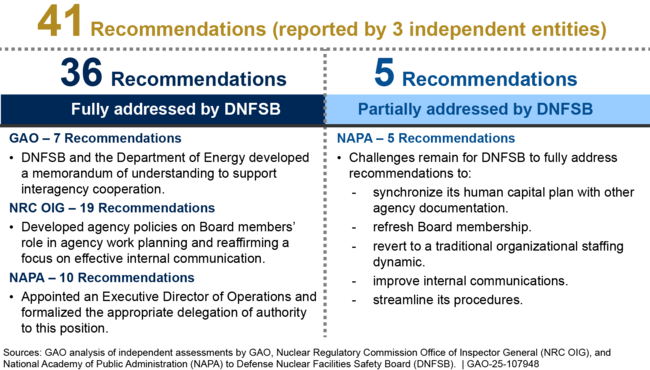Defense Nuclear Facilities Safety Board: Opportunities Exist to Further Improve Management and Planning
Fast Facts
The Defense Nuclear Facilities Safety Board is the only federal agency that provides independent safety oversight at nuclear sites. The agency is headed by its Board with up to 5 members.
But prior assessments described a deterioration in the agency's effectiveness that was largely driven by dysfunctional relationships among the Board members.
The agency fully addressed most of the previously identified issues and continues to address others, such as streamlining its procedures.
To build on progress, we recommended that the agency further develop its human capital plan.

Source: Defense Nuclear Facilities Safety Board.
The agency seal which includes a banner reading "Salus atque securitas," over an eagle sitting atop a shield with an atomic symbol, on top of two leafy branches. The text encircling the image reads "United States of America Defense Nuclear Facilities Safety Board."
Highlights
What GAO Found
GAO assessed the status of 41 recommendations made by GAO, the Nuclear Regulatory Commission’s Office of Inspector General (NRC OIG), and the National Academy of Public Administration (NAPA) to the Defense Nuclear Facilities Safety Board (DNFSB). DNFSB is responsible for providing independent oversight of the Department of Energy’s (DOE) public health and safety protections at its sites.
As shown below, GAO found that DNFSB had fully addressed 36 of the recommendations and partially addressed the remaining five. DNFSB’s actions have generally helped enhance collaboration with stakeholders, improve procedures, and improve employee morale. GAO, NRC OIG, and NAPA made these recommendations in response to shortcomings they identified in DNFSB’s management that resulted in a dysfunctional organizational culture and performance problems. These assessments described a deterioration in DNFSB’s planning and effectiveness that was largely driven by the divisive and dysfunctional relationships among the agency’s Board members. The resulting recommendations generally focused on cultivating DNFSB’s ability to enhance collaboration with stakeholders, improve planning and procedures, and improve employee morale.
Status of Independent Entities’ Recommendations to DNFSB and Actions Taken to Address Them

GAO found that DNFSB has not fully addressed five recommendations that NAPA made in 2018. These included recommendations to improve its human capital planning and to refresh the Board’s membership. GAO found that DNFSB developed its first human capital plan in late 2024, but the plan does not include implementation details on what is to be achieved, who is to achieve it, how it will be achieved, and by when. Because DNFSB’s primary resource is its people, ensuring that employee roles in supporting the agency’s mission are well defined will help ensure the most efficient and effective use of budget and the best mission outcomes. A more actionable future iteration of the plan that details how DNFSB can progress toward stated goals would help the agency to more effectively navigate unplanned agency pivots with minimal disruption to agency mission.
In addition to improving human capital planning, GAO found that filling empty Board seats remains challenging for DNFSB because the five members of the Board must be appointed by the President and confirmed by the Senate. In January 2025, the Board fell to two members, which resulted in a loss of quorum for the second time in the last 2 years and in the agency’s history. According to DNFSB officials, a Board below quorum poses a substantial risk to the agency’s ability to execute its mission of providing independent safety oversight of the DOE’s processes that could cause nuclear accidents.
In October 2025, the Board could fall to one member and consequently lose its ability to issue recommendations or hold hearings on critical nuclear safety issues. DNFSB officials said that not having a full five-member Board to deliberate on and support the agency’s findings may also lead DOE to take DNFSB’s technical correspondences less seriously. Current Board members and officials said that they have communicated these concerns to the White House and Congress.
Why GAO Did This Study
DNFSB is the only federal agency that provides independent oversight of whether DOE’s public health and safety protections are adequate at the approximately 100 defense nuclear facilities across 10 active DOE sites in the United States. Defense nuclear facilities are defined as being under the control or jurisdiction of the Secretary of Energy and include production or utilization facilities operated for national security purposes or nuclear waste storage facilities. DNFSB’s ability to work as an independent oversight body is central to preventing high-consequence (but typically low-probability) threats to communities and the environment by, for example, providing oversight over processes that could cause nuclear accidents.
Senate Report No. 118-188 includes a provision for GAO to conduct a general management review of the DNFSB with a focus on whether past findings from independent assessments have been addressed. This report addresses (1) how DNFSB has responded to recommendations from past independent assessments and (2) what recommendations remain challenging for DNFSB to implement.
To address these objectives, GAO reviewed and assessed the status of recommendations from GAO, NRC OIG, and NAPA. GAO also interviewed officials from DNFSB, including Board members, officials from NRC OIG, and representatives from NAPA.
Recommendations
GAO recommends that DNFSB revise and further develop its human capital plan to include implementation details including who is responsible and time frames for achieving its goals
Recommendations for Executive Action
| Agency Affected | Recommendation | Status |
|---|---|---|
| Defense Nuclear Facilities Safety Board | DNFSB should update its 2024 human capital plan so that it better aligns with internal control standards and includes: (1) what is to be achieved, (2) who is to achieve it, (3) how it will be achieved, and (4) the time frames for achieving it. (Recommendation 1) |
DNFSB concurred with this recommendation. In its July 2025 response letter, DNFSB stated that the agency will integrate its human capital plan into broader implementation activities to ensure the workforce is optimally aligned with strategic objectives. When we confirm what actions DNFSB has taken in response to this recommendation, we will provide updated information.
|
